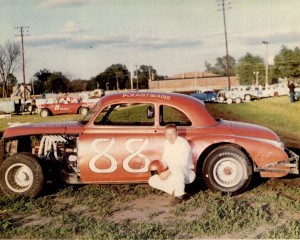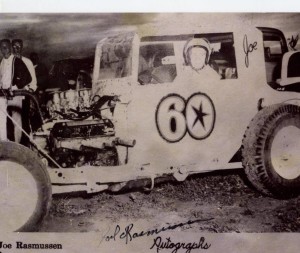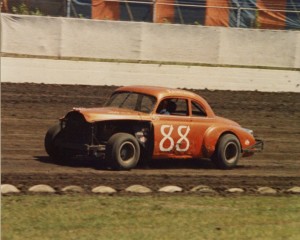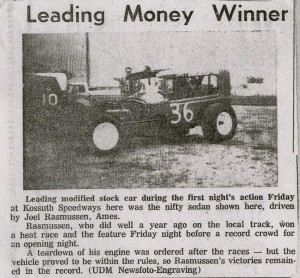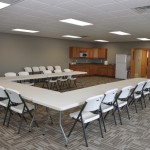By Chad Meyer
Fresh out of the United States Army in January 1956, springtime found Joel Rasmussen making trips to the dirt track in Iowa Falls. It was here where he fell in love with the sport, making the trip from Ames nearly every week.
“Ernie Derr and Ramo Stott were big racing stars then, and I really liked watching them race,” said Rasmussen. “In 1957, on the way back from the Iowa Falls races, I bought a 1941 Ford coupe and made it into a race car.”
He said it was spur of the moment decision to buy that first race car. “I didn’t know anything about building a race car then. That first car didn’t even have shocks on when I took it to the track,” laughed Rasmussen.
“We were such greenhorns. That first race at Iowa Falls I didn’t have a helmet, goggles or even seat belts,” he explained. “The track promoter took me uptown to the Army Surplus store, and I bought all that stuff for $7.00.”
Then, the economics of racing were much different than today. Rasmussen’s first car cost $45 to build. “It cost one dollar to race or to watch the race. If you won at Belmond, though, it paid $200 to win,” he recalled.
Not only was the money good there, so was the competition. “In the late 1950’s everyone said the fast cars were at Belmond, and we couldn’t wait to get there,” he said.
Rasmussen credits Del Stokke for helping get his career to the next step. Rasmussen began to understand the cars better, and Stokke was a master with engines.
“Del came from a drag racing background and was a great mechanic,” he recalls. “He’d adjust that engine two to three times a night. When we got to racing together, we were hard to beat.”
It was in the mid-1960’s when he first made the trip north to the track in Algona. “I recall they had a Nationals type race then with modifieds, and the extra money is what brought us there the first time. We did very well in that race, and we decided to keep coming up there for the next couple of years,” said Rasumussen.
“We did well at Algona. Back then, if you made the top three, your engine got tore down. And we got tore down a lot there. They never did find anything wrong, though and we won several races there.”
In 1964, track promoter Lamont Wellendorf’s three track circuit that included Algona, crowned an overall champion. Stacy Redmond won the top prize at the end of the year, with Rasmussen finishing second.
As the modifieds transitioned into super-modifieds and then sprint cars, Rasumussen opted to stick with stock bodied cars. It was with a 1950 Oldsmobile coupe that he found some of his greatest success behind the wheel.
“I wanted to do something different, and an Olds bodied car with an Oldsmobile engine was certainly unique then. Keith Knaack of Hawkeye Racing News said we were nuts. But by the end of the year, he said we were one of the best non-professional race teams in Iowa,” Rasmussen said.
In 1968 the race team won the Marshalltown and Oskaloosa season championships, and beat George Barton to win a big race a Knoxville. The night before the Iowa State Fair, he charged from ninth in the feature to win at Oskaloosa.
“Our biggest win was the Iowa State Fair race that year, something I’m still proud of today,” said Rasmussen, who went to say they finished second in that event the next two years.
Stock bodied race cars transitioned into what is now known as late models and Rasmussen made the transition as well. “We bounced around a bit in the 1970’s, and sat out for a bit.”
That changed in 1976 when he campaigned a Sanger Chassis owned by Chuck Cox from Boone. “After we got the car about mid-season, we raced seven nights at Webster City and won five times with a couple second place finishes. Boy, I loved that track!”
A new Sanger Chassis in ’77 didn’t yield the same results. The rise in costs to field a competitive car caused Rasmussen to retire from the sport in the early 1980’s.
“Throughout my career, if we didn’t have the money to race, we didn’t go. But if had the money, we’d race just about anywhere,” he said.
Today, Rasmussen is retired and lives near Ames.
Rasmussen joins six others as inductees into the Kossuth County Racing Hall of Fame. More information about the hall of fame and the ceremony is available at www.KossuthMuseum.com.
